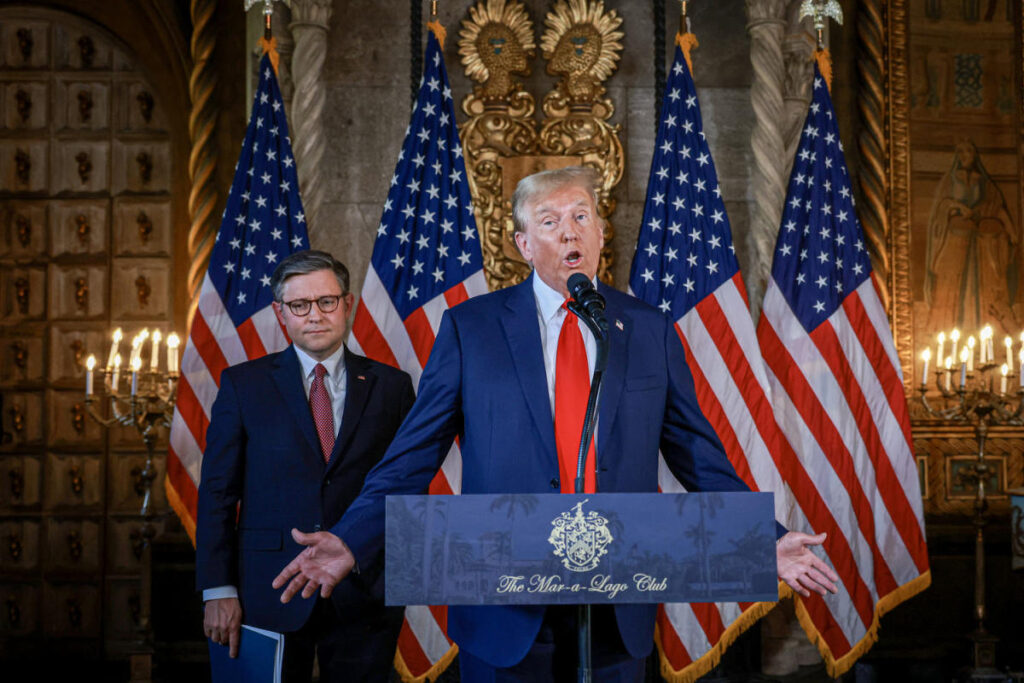The latest edition of “From the Politics Desk,” an evening newsletter by the NBC News Politics team, provides an in-depth analysis of the current political landscape as former President Donald Trump re-emerges in the political arena. National political reporter Ben Kamisar highlights the growing alignment of House Republicans with Trump, noting that a significant portion of the incoming GOP majority gained their positions during or after Trump’s presidency. This affiliation indicates a deepening allegiance among these members, who have become accustomed to Trump’s style of leadership. Some representatives openly express their unwavering support for Trump, viewing him as a pivotal figure in their party’s future, likened to “the greatest thing since sliced bread,” as articulated by Rep. Troy Nehls of Texas. However, the narrow majority anticipated for House Republicans may create challenges in advancing Trump’s agenda, particularly as he considers nominating some House members for his administration.
Kamisar further contrasts the dynamics between the House and the Senate. Despite House Republicans being generally more receptive to Trump’s influence, the Senate presents a different scenario. The Senate GOP could hold a slight majority, but many of its members predate Trump’s era, fostering a more traditional Republican perspective compared to the House. Newly-elected Senate leader John Thune embodies this institution-bound approach, complicating Trump’s ability to exert the same level of control as he might in the House. This contrast becomes particularly relevant as Senate Republicans prepare to evaluate Trump’s Cabinet nominations, a process that could reveal differing levels of support and resistance among Republican senators.
Transitioning into Trump’s Cabinet choices, “Meet the Press” moderator Kristen Welker examines the notable differences between Trump’s upcoming appointments and those from his first term. Trump has moved quickly to announce his selections for key positions well in advance of his inauguration, showcasing a strategic approach aimed at ensuring a swift implementation of his policies. Current picks include prominent figures such as Marco Rubio and Matt Gaetz for critical roles like the State and Justice Departments, a shift from the establishment-oriented approach seen eight years prior. The early announcements signify Trump’s intent to demonstrate decisiveness and a focus on a non-traditional cadre of advisors, potentially testing the loyalty of Republican senators against more controversial figures like Gaetz, who is associated with significant political turmoil.
However, the reactions to these nominations also underscore the complexities at play. While some party members express discomfort with specific appointments, such as Gaetz, it remains unclear if these sentiments will translate into outright dissent among Republican senators, who have not yet shown a unified front against him. Welker’s analysis reveals that Trump’s selection process serves dual purposes: advancing his administration’s agenda while simultaneously gauging the commitment of Republican leadership to him. As he appoints advisors like Robert F. Kennedy Jr. to headline departments that address pivotal issues, the implications of his choices may resonate deeply within the party’s framework.
Amid these discussions, the newsletter highlights the broader political context, where several pivotal factors threaten the legacy of current President Joe Biden. Trump’s anticipated return has raised questions about the future of Biden’s executive actions on multiple fronts, including immigration and LGBTQ rights. Although undoing bipartisan legislation may be challenging, Trump’s resurgence places immense pressure on Democratic successes and past achievements. The author points out the resilience of Republican control, with GOP hopes extending beyond just the federal level to state legislative chambers, further solidifying the party’s foothold and strategic advantages as they prepare for the political battles ahead.
As the political climate evolves, emerging candidates and strategies also come into play. In New Jersey, Rep. Josh Gottheimer steps into the spotlight, joining a competitive Democratic primary for governor, where the stakes are high for Democrats looking to reclaim influence. On the Republican side, Trump’s team is advancing plans for a new super PAC to support Senate races in 2026, indicating a long-view approach to consolidating power. Additionally, Democrats are prompted to recalibrate their primary calendar strategies for the 2028 presidential race, revealing ongoing efforts to adapt to the shifting political terrain. In this rapidly changing landscape, the interplay of alliances, party dynamics, and election strategies will be pivotal as both parties gear up for an active political cycle.
In conclusion, the newsletter paints a vivid picture of a political landscape increasingly dominated by Trump’s renewed influence over the Republican Party. With the House aligning more firmly with Trump and the Senate navigating past allegiances, the formation of a new Cabinet heralds a shift toward a Trump-centric governance model. Various dynamics, including Republicans’ responses to Trump’s appointments, Biden’s precarious legislative legacy, and electoral strategies for future elections, will likely define the upcoming political climate. As political power shifts, the implications of these developments will resonate deeply as both parties prepare for an uncertain but pivotal future.

